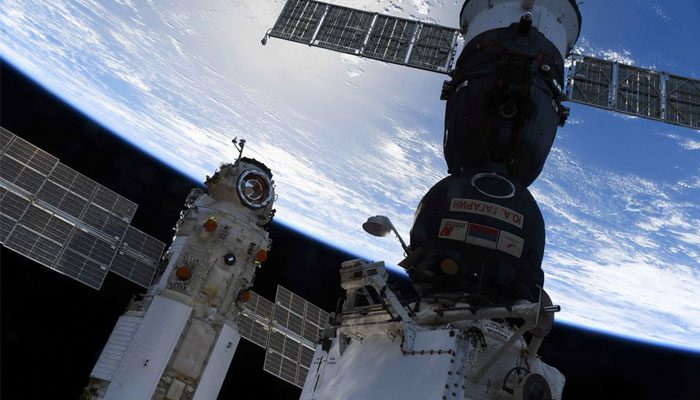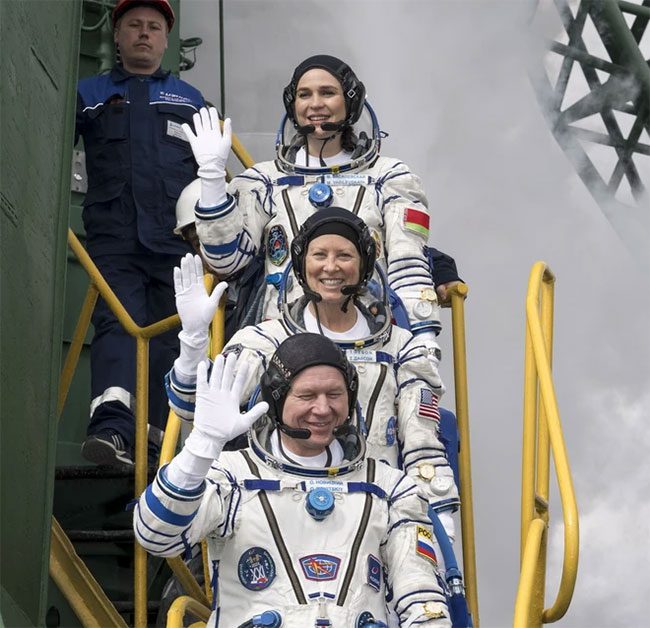Setting aside political differences and disagreements, many world powers such as Russia, the United States, China, and Japan continue to collaborate to bring significant achievements to humanity in space exploration.
Exactly 63 years ago, on April 12, 1961, astronaut Yuri Gagarin became the first person to travel into space aboard the Vostok spacecraft.

The Nauka module from the Russian Federal Space Agency Roscosmos landed on the International Space Station on July 29, 2021. (Photo: AFP/TTXVN).
This achievement not only represented a source of pride for the Soviet Union at the time but also marked a breakthrough in humanity’s quest to conquer space, ushering in a new era in the history of world science: The Era of Humanity Conquering Space and Conducting Scientific Research in Space.
To commemorate this remarkable achievement, in 2011, the United Nations General Assembly adopted an official resolution declaring April 12 as International Day of Human Space Flight.
Gagarin’s successful flight brought joy and became an inspiration for everyone to pursue the dream of “reaching for the stars.”
The global aerospace industry continues to advance, expanding its reach into new realms of space. Since then, hundreds of men and women from various countries have ventured into space. In recent orbital flights, there have been not only astronauts but also tourists.
For many astronauts, space flights have become commonplace; they experience their presence in orbit as just another job.
On the International Space Station (ISS)—a collaboration involving 15 countries—scientists operate life support systems and conduct experiments in astronomy, engineering, biomedicine, and more.
They also learn how to live and work for extended periods in low Earth orbit, launch various equipment and machinery to nearby and distant planets, and prepare for crewed missions to Mars…
The aerospace sector continues to witness significant advancements, opening new hopes for the connection between humanity and space.
2023 has been a year marked by many significant events in humanity’s conquest of space: India successfully landed a spacecraft at the Moon’s South Pole, the U.S. National Aeronautics and Space Administration (NASA) returned asteroid samples to Earth for study, billionaire Elon Musk’s SpaceX launched nearly 100 rockets, while Japan and Europe deployed new space telescopes into orbit…
Deep space exploration projects are expected to be even more vigorously pursued in 2024, with the Moon remaining a primary target.
On January 20, Japan became the fifth country to successfully land an unmanned spacecraft on the Moon (following the former Soviet Union, the United States, China, and India).
Notably, the Smart Lunar Lander (SLIM) of Japan achieved a milestone by surviving two extremely cold lunar nights (at -183 degrees Celsius and -130 degrees Celsius, respectively) despite not being designed for such conditions.
Additionally, SLIM demonstrated high-precision landing technology—a significant advancement crucial for searching for water and oxygen on the Moon, essential elements for human survival.
Unfortunately for SLIM, the unmanned lander Odysseus from Intuitive Machines (U.S.) was unable to “wake up” after the extreme cold, becoming the first private spacecraft to “sleep forever” on the Moon.

Astronauts were taken to the International Space Station (ISS) by the Russian Soyuz spacecraft from the Baikonur spaceport in Kazakhstan on March 23, 2024. (Photo: AFP/TTXVN)
Despite this, the landing of the Odysseus on February 22 marked the first time a U.S. spacecraft has landed on the Moon since the Apollo 17 (crewed) mission in 1972, and it was also the first commercial lander to touch down on Earth’s only natural satellite.
The United States is preparing to launch Mission Artemis 2 in November, when a group of four astronauts will travel around the Moon and return. They will be the first humans to travel near the Moon since 1972, when the Apollo 17 mission concluded.
Additionally, NASA plans to launch the Europa Clipper in October to explore Europa—one of Jupiter’s moons.
Europa has an icy surface and is believed to be concealing a vast ocean that scientists suggest may harbor conditions suitable for life.
China is also planning to launch a lunar probe for the fourth time. According to the plan, the Chang’e 6 spacecraft may head towards the Moon’s far side in May 2024 to collect rock and dust samples to return to Earth for study.
If successful, this mission would mark the first time that soil samples have been returned from an area of the Moon that has never been explored by humans.
India is also busy preparing to implement at least 12 missions, including testing a crewed spacecraft and a humanoid robot named Vyomitra in space, before carrying out the Gaganyaan mission—sending a crew of three members into orbit 400 km around the Earth for a three-day mission in 2025.
India is also advancing the next phases of its Mars orbital mission, aimed at studying the surface, atmosphere, and climate conditions of the “Red Planet.”
Additionally, there is a mission to orbit Venus. Indian Prime Minister Narendra Modi aims to establish the country’s own space station by 2035 and send the first Indian to the Moon by 2040.
A number of companies like Boeing, Lockheed Martin, Blue Origin, and LandSpace Technology are also racing to develop launch vehicles, focusing on reusability—an approach pioneered by SpaceX. Currently, SpaceX is in the process of developing the massive Starship spacecraft, designed for multiple “round trips” from Earth to the Moon or Mars.
Multinational Bank of America predicts that the space industry will experience robust growth, with estimated scale reaching $1.4 trillion by 2030. It is evident that, although each nation has its own approaches suited to its capabilities, the spirit of close cooperation and healthy competition truly leaves a mark.
“From space, I no longer see the borders of nations! The Earth is one eternal green.” This was Yuri Gagarin’s first remark sent from space back to Earth, embodying the timeless message of peace he wished to convey to people around the globe.
Setting aside differences and political disagreements, many world powers such as Russia, the United States, China, and Japan continue to collaborate to bring significant achievements to humanity in the process of exploring space.
Russian President Vladimir Putin has emphasized: “Space is a realm of joint activities, allowing us to forget all the complexities in international relations and promote activities in high-tech fields for the future of nations and humanity.”
He called for not “politicizing space,” urging for expanded international cooperation in space research for the common good of humanity.
In fact, in recent years, cooperative space exploration has been one of the few areas of international collaboration between Russia and the U.S. that has not been affected by the political tensions between the two countries.
The cooperation agreement in space research and utilization for peaceful purposes between Russia and the U.S., signed in 1992, is one of the fundamental legal frameworks facilitating collaborative efforts in space exploration.
Since then, this agreement has been extended four times, at least until December 2030. The extension of this agreement will meet the interests of both parties, promoting the effective implementation of common space projects, and once again affirming that: From space, Earth is a shared home.





















































